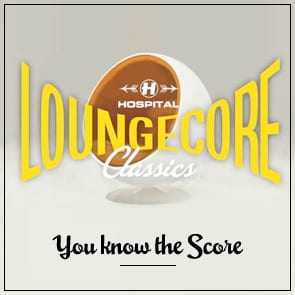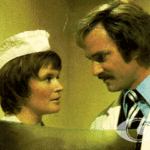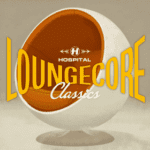 Last week saw the release of a 28 track long Hospital history lesson. Tracing their roots through their deepest, funkiest, jazziest and most unpredictable releases, it stretches as far back as the label’s earliest releases such as Peter Nice Trio’s Harp Of Gold right through to Stanza’s Rose Garden. They call it Loungecore. We call it gosh darn funky. A perfect counter to the vibrant, technicolour electro-tinged romps they’ve been smashing the dance with recently, this flavoured playlist is the one that originally put Hospital on the map. We thought we’d give label boss London Elektricity a call to find out more…
Last week saw the release of a 28 track long Hospital history lesson. Tracing their roots through their deepest, funkiest, jazziest and most unpredictable releases, it stretches as far back as the label’s earliest releases such as Peter Nice Trio’s Harp Of Gold right through to Stanza’s Rose Garden. They call it Loungecore. We call it gosh darn funky. A perfect counter to the vibrant, technicolour electro-tinged romps they’ve been smashing the dance with recently, this flavoured playlist is the one that originally put Hospital on the map. We thought we’d give label boss London Elektricity a call to find out more…
“I’ve wanted to release Loungecore Classics for about three years,” he says. “It’s perfect timing right now. There are a lot of people getting into drum & bass for the first time, getting into Hospital and other labels, and a lot of them weren’t even born when some of these were released. I’ve chatted to people who were three or four when the first Peter Nice Trio record came out. It’s great music, it’s roots of Hospital and we need people to hear it and understand it. And hopefully enjoy it!”
While the idea of lounge screams smoking jackets and brothel creepers, one quick blast on any one of these tunes will indicate fantastic DJ fodder… the title comes from the music’s roots: finding the maddest lounge record and hammering it to pieces with a good old Akai sampler. This is how it all began! Not just for Hospital but for jungle and drum & bass as a whole…
“When we started we used the term jokingly because we thought it was funny,” he tells us. “A combination of lounge music and hardcore! But that was how we made the tunes; we’d trawl through second hand record shops and car boot sales looking for the worse possible lounge albums then raped it with our samplers and put an Amen on it. That’s a very crude description of what we were up to.
 “General Hospital is a great example of pure loungecore. It’s basically a remix of a theme from a 70s soap on ITV! It was like Prisoner Cell Block H but in hospitals. We cleared it with EMI and it’s like a game show theme that goes into a drum & bass tune.”
“General Hospital is a great example of pure loungecore. It’s basically a remix of a theme from a 70s soap on ITV! It was like Prisoner Cell Block H but in hospitals. We cleared it with EMI and it’s like a game show theme that goes into a drum & bass tune.”
Dial S For Sampler
You see, Loungcore doesn’t just highlight the rich, funk-flecked history London’s megalabel. It’s a kindly reminder of the dark art of sampling. Something Mr Coleman believes we shouldn’t forget in a hurry….
“There are so many sample packs available now, which make things very convenient, but it means a lot of tunes sound very similar,” he states. “It’s great in as much as the music is 100% legal but it means some of the music has lost its character and indentity. The reason why classic hip-hop and original early drum & bass sounded so original is because of great sample use.”
Naturally a label with the clout, repertoire and size of Hospital can still dedicate time and finances to sampling clearing (within reason of course) if you can dedicate your own time into finding the samples yourself. Patience is key; you’re looking for a sonic needle in endless crates of scratchy, often terrible sounding haystacks.
 “How many times have I bought a lounge record and found it too bad to sample? Always!” he laughs. “Pretty much every time. I moved in January and I’ve spent six months going through boxes and boxes of vinyl that fall in that category. I’d say half the records I bought to sample I’ve not even listened to yet. I need to prioritise. Some are so bad I’m keeping them. They’re so bad they’re actually nice. I got this one record by a bloke called David Disco. It’s appaling but it’s got the best cover ever. That’s going on the wall! You can have an hour of the worse possible music ever. Something you really shouldn’t subject your ears to, but in the middle you’ll find that one little drum break which you can base a whole tune around….”
“How many times have I bought a lounge record and found it too bad to sample? Always!” he laughs. “Pretty much every time. I moved in January and I’ve spent six months going through boxes and boxes of vinyl that fall in that category. I’d say half the records I bought to sample I’ve not even listened to yet. I need to prioritise. Some are so bad I’m keeping them. They’re so bad they’re actually nice. I got this one record by a bloke called David Disco. It’s appaling but it’s got the best cover ever. That’s going on the wall! You can have an hour of the worse possible music ever. Something you really shouldn’t subject your ears to, but in the middle you’ll find that one little drum break which you can base a whole tune around….”
Tony’s Top Sample Searching Tips!
The artwork is important. I’ll defy anyone who says it isn’t. Sometimes that rule goes out of the window but be prepared to take the risk. If it looks like it contrains good samples from the artwork then get it. If it’s got a women with her tits out then it’s almost guaranteed to have a good sample. And if it hasn’t? It doesn’t matter… She’s got her tits out and you can put it on the studio wall!
If you’ve got any knowledge of music and producers then look at the credits and see who’s behind it. Do research and get digging.
Old covers, especially of tracks like Light My Fire or Hey Jude, have often got great drum breaks on them. You might not end up using them; you use them as a base for an idea or a tune then end up replacing the sounds but keeping the feel. Turn it into a MIDI file and replace it with super fat new sounds. Or back it up with more modern beef.
It’s the same with a great orchestral sample. You don’t need to use it; you can put it into Melodyne and it can out put a MIDI file. You can twist everything these days….
Loungecore Classics is out now. Listen & download
